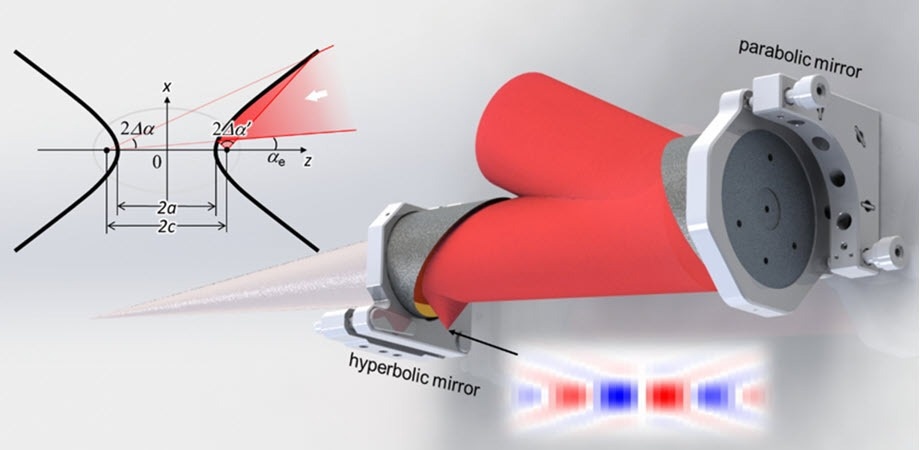Strong instruments employed in physics, national security, industry, and medicine are ultra-intense ultrashort lasers. They support investigations into particle acceleration, laser-driven radiation sources, strong-field laser physics, and other topics.
 Secondary focusing with hyperbola after parabola. Image Credit: Zhaoyang Li
Secondary focusing with hyperbola after parabola. Image Credit: Zhaoyang Li
The intensity of these lasers is measured in terms of “peak power.” Such lasers include the 1.5 PW Nova laser at Lawrence Livermore National Laboratory in California, the 10 PW Shanghai Super-intense Ultrafast Laser Facility, and the 10 PW Extreme Light Infrastructure – Nuclear Physics laser.
However, in experiments, it is the intensity with which one is focused on the target that counts. Off-axis parabolic mirrors are used to focus the lasers on experimental targets. Users must understand that focused intensity, not peak power, indicates the laser's capacity.
Enhancing Focus with Hyperbolic Mirrors
These lasers now have a beam aperture of 150 to 500 mm and an F-number of 2 to 10, which indicates their capacity to focus. Removing the parabolic mirror and adding a rotational hyperbolic mirror can significantly decrease the F-number and focal point size.
This secondary focusing technique can lower the F-number by a factor of 5, reducing the focal spot size of the ultra-intense ultrashort laser to a single-wavelength size, as reported in the journal Advanced Photonics Nexus.
Corresponding author Zhaoyang Li of the Key Laboratory of Ultra-intense Laser Science and Technology, Shanghai Institute of Optics and Fine Mechanics, noted that this technique enables the smallest possible focal spot: “Utilizing hyperbolic mirrors for secondary focusing can reduce the focal spot of our ultra-intense ultrashort lasers from a several-wavelength size to just a single-wavelength size, achieving the smallest focal spot possible.”
According to Li and his colleagues, future single-cycle petawatt-class lasers or existing femtosecond petawatt-class lasers can be equipped with an optimized rotational hyperbolic mirror to produce single-wavelength focal spots.
In combination with our previously proposed Wide-angle Non-collinear Optical Parametric Chirped Pulse Amplification (WNOPCPA) method, it is expected to reach the highest intensity condition of an ultra-intense ultrashort laser facility, that is focusing all laser energy into a spatiotemporal focal cube edged by the laser center wavelength. This will dramatically enhance the experimental capability of ultra-intense ultrashort lasers in the application of strong-field laser physics, such as vacuum quantum electrodynamics.
Zhaoyang Li, Study Corresponding Author, Key Laboratory of Ultra-intense Laser Science and Technology, Shanghai Institute of Optics and Fine Mechanics
Journal Reference:
Li, Z., et al. (2024) Single-wavelength size focusing of ultra-intense ultrashort lasers with rotational hyperbolic mirrors. Advanced Photonics Nexus. doi.org/10.1117/1.apn.3.3.036002